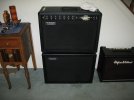KraftyBob
Well-Known Member
Well, new to me anyhow...
I have another post asking for opinions about the amp, but since I went ahead and bought it I figured I'd post the obligatory NAD thread The amp is like new and has the blue alligator skin Tolex - which initially I wasn't sure about but I really like it in person. It's different. The previous owner put in a WGS Retro 30 speaker which I really like. Didn't have a chance to hear the stock speaker but I have no complaints with the WGS.
The amp is like new and has the blue alligator skin Tolex - which initially I wasn't sure about but I really like it in person. It's different. The previous owner put in a WGS Retro 30 speaker which I really like. Didn't have a chance to hear the stock speaker but I have no complaints with the WGS.
I did a fair amount of reading before I bought it and posted on my other thread that opinions on Mesa's seem to be like Sushi - you either love them or can't stand them. There's not much middle ground. But So far I'm really liking what I'm hearing - and that's at lower volumes. I’m pleasantly surprised how good the cleans are because being limited on physical space since we moved, I’ve made myself a personal policy of one in / one out and wasn’t sure what I was going to unload. Now I’m thinking my Fender HR DeVille might be a good candidate since I can get good cleans from the Mesa. Although, rules can be broken...
The Rectoverb has a parallel effects loop (like other older Mesa's) but there’s an easy (and reversible) mod to convert it to serial so I can use my Helix in 4CM like I do with my other amps. Anyhow, here it is:

I have another post asking for opinions about the amp, but since I went ahead and bought it I figured I'd post the obligatory NAD thread
 The amp is like new and has the blue alligator skin Tolex - which initially I wasn't sure about but I really like it in person. It's different. The previous owner put in a WGS Retro 30 speaker which I really like. Didn't have a chance to hear the stock speaker but I have no complaints with the WGS.
The amp is like new and has the blue alligator skin Tolex - which initially I wasn't sure about but I really like it in person. It's different. The previous owner put in a WGS Retro 30 speaker which I really like. Didn't have a chance to hear the stock speaker but I have no complaints with the WGS.I did a fair amount of reading before I bought it and posted on my other thread that opinions on Mesa's seem to be like Sushi - you either love them or can't stand them. There's not much middle ground. But So far I'm really liking what I'm hearing - and that's at lower volumes. I’m pleasantly surprised how good the cleans are because being limited on physical space since we moved, I’ve made myself a personal policy of one in / one out and wasn’t sure what I was going to unload. Now I’m thinking my Fender HR DeVille might be a good candidate since I can get good cleans from the Mesa. Although, rules can be broken...
The Rectoverb has a parallel effects loop (like other older Mesa's) but there’s an easy (and reversible) mod to convert it to serial so I can use my Helix in 4CM like I do with my other amps. Anyhow, here it is:

Last edited:




